As a homeowner, you’re likely proud of the beauty and benefits your trees bring to your property. However, to keep them healthy and thriving, it’s crucial to provide proper care throughout the year.
Different seasons bring unique challenges for your trees, from harsh winter conditions to scorching summer heat. By understanding and addressing these seasonal needs, you can ensure your trees receive the right care at the right time.
Effective year-round tree maintenance involves more than just occasional pruning or watering; it requires a comprehensive approach that considers the changing needs of your trees as the seasons change.
Key Takeaways
- Understand the seasonal needs of your trees.
- Learn how to protect your trees from extreme weather conditions.
- Discover the importance of regular tree inspection.
- Find out how to adjust your tree care routine for different seasons.
- Gain insights into maintaining tree health throughout the year.
The Importance of Year-Round Tree Maintenance
Trees need care all year to stay healthy. If you ignore them, problems like pests and damage can happen.
How Seasonal Changes Affect Tree Health
Seasonal changes really affect trees. They face different temperatures, daylight, and weather. This can stress or harm them if not cared for right.
Temperature Fluctuations and Tree Stress
Temperature changes stress trees a lot. Extreme heat or cold can hurt their tissues. This makes them more likely to get sick or attract pests.
Daylight Changes and Growth Patterns
Daylight changes affect how trees grow. Trees adjust their growth with the seasons. The right care can help or hurt this process.
Benefits of Consistent Tree Care
Regular tree care has many benefits. It boosts your property’s value and helps the environment. Keeping your trees healthy all year makes your landscape better and greener.
Enhanced Property Value
Good tree care can really boost your property’s value. Healthy trees are attractive to homeowners. They make your property more appealing.
Environmental Contributions
Trees also do a lot for the environment. They clean the air, support wildlife, and fight climate change.
Understanding Your Trees: Species and Growth Patterns
Knowing if your trees are deciduous or evergreen is just the beginning. It’s key to understand their species and growth patterns for proper care. Each tree species has its own needs for it to grow well.
Deciduous vs. Evergreen Care Requirements
Deciduous and evergreen trees have different needs. Deciduous trees lose their leaves every year. Evergreen trees keep their leaves all year.
Leaf-Shedding Trees and Their Needs
Deciduous trees, like oak and maple, need more water when they’re growing. They also do well with regular pruning to stay healthy.
Year-Round Foliage Management
Evergreen trees, such as pine and spruce, need steady moisture, especially when it’s dry. Mulching helps keep the soil moist and the right temperature.
Identifying Your Trees’ Growth Stages
Knowing your trees’ growth stage is crucial for the right care. Trees go through stages from young to mature.
Young Tree Establishment
Young trees need lots of care, like regular watering and pruning. This helps them grow strong roots and a good shape.
Mature Tree Maintenance
Mature trees need ongoing care, like pruning to remove dead branches. They also need checks for diseases or pests.
By knowing your trees’ species and growth patterns, you can tailor your tree care to their needs. This ensures they stay healthy and flourish all year.
Essential Tools for Year-Round Tree Maintenance
Starting tree maintenance right means having the right tools. Whether you’re cutting branches or checking for damage, the right tools are key. They help keep your trees healthy and growing well.
Basic Tree Care Equipment
Having the right tools is crucial for good tree care. You’ll need tools for cutting and pruning. Also, safety gear to protect you from dangers.
Cutting and Pruning Tools
For tree pruning and tree trimming techniques, you need quality cutting tools. These include:
- Pruning shears for smaller branches
- Loppers for thicker branches
- Pruning saws for larger limbs
Safety Equipment Essentials
When you’re doing tree maintenance, safety comes first. You’ll need:
- Gloves to protect your hands from splinters and cuts
- Safety glasses to keep your eyes safe from debris
- A hard hat to protect your head from falling branches
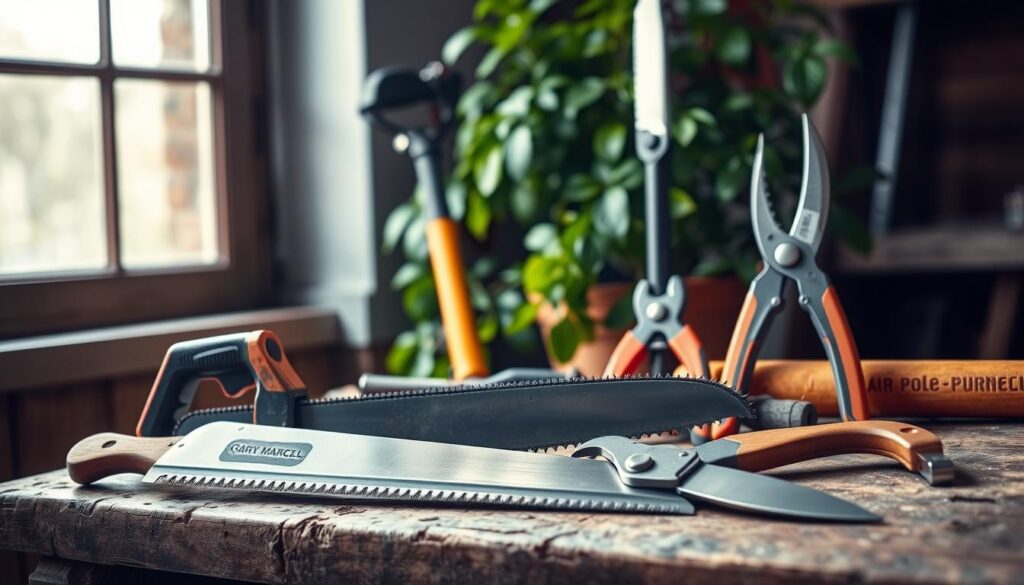
Seasonal Tool Maintenance
To keep your tools working well, regular maintenance is key. This means cleaning and disinfecting them. Also, storing them right.
Cleaning and Disinfection Protocols
After each use, clean your tools to stop disease spread. Use a disinfectant on cutting surfaces, especially when moving between trees.
Storage Best Practices
Keep your tools in a dry, safe spot. Hang bigger tools like pruning saws and loppers. This keeps them organized and easy to find.
| Tool | Maintenance Task | Storage Tip |
|---|---|---|
| Pruning Shears | Clean and disinfect after use | Store in a dry place |
| Loppers | Oil moving parts regularly | Hang on a hook |
| Pruning Saws | Sharpen periodically | Keep in a protective case |
Spring Tree Care: Awakening Your Landscape
Spring is a key time for tree care. It sets the stage for the growing season. As the weather warms and trees grow, it’s important to meet their needs.
Post-Winter Inspection Techniques
After a harsh winter, checking your trees is crucial. You need to find any damage or issues that need fixing.
Identifying Winter Damage
Look for signs of winter damage. Check for cracked or split branches, dead foliage, or exposed roots. Finding these early helps fix problems quickly.
Structural Assessment Methods
Check your trees’ structure by looking at branches, trunk, and roots. Look for decay or weakness signs.
Spring Pruning Guidelines
Pruning in spring is key for tree health and new growth.
Timing for Different Species
Pruning times vary by tree species. For example, deciduous trees are pruned before they leaf out. Evergreen trees are pruned in early spring.
Proper Cutting Techniques
Use the right cutting techniques to avoid harming the tree. Make clean cuts just outside the branch collar. Avoid leaving stubs.
Fertilization Strategies for Spring Growth
Fertilizing in spring gives trees the nutrients they need for growth.
Slow-Release vs. Quick-Release Options
Choose slow-release fertilizers for steady nutrient delivery. Or use quick-release options for fast support.
Application Methods and Timing
Follow the manufacturer’s instructions for fertilizing. Do it in early spring when the ground is thawed.
| Tree Care Activity | Timing | Benefits |
|---|---|---|
| Post-Winter Inspection | Early Spring | Identify and address winter damage |
| Spring Pruning | Before leaf-out | Promotes healthy growth and structure |
| Fertilization | Early Spring | Provides essential nutrients for growth |
Managing Spring Pests and Diseases
Spring brings new life to your trees, but it also introduces pests and diseases. As the weather warms up, insects and pathogens become active. They can cause significant damage to your trees. It’s important to manage these threats to keep your trees healthy.
Common Spring Tree Pests in the United States
In the spring, trees face various pests that can harm them. Aphids, caterpillars, and scale insects are common. These pests can weaken trees by feeding on their sap, leaves, or bark.
Early Season Insects and Their Impact
Aphids and caterpillars can significantly impact tree health in the early season. Aphids feed on sap, causing curled or distorted leaves. Caterpillars can defoliate trees, reducing photosynthesis. Monitoring your trees regularly helps detect these pests early.
Disease Vectors and Prevention
Some insects spread diseases to trees. For example, certain beetles can spread Dutch elm disease. Preventing disease spread involves managing insect vectors and keeping trees healthy through proper care.
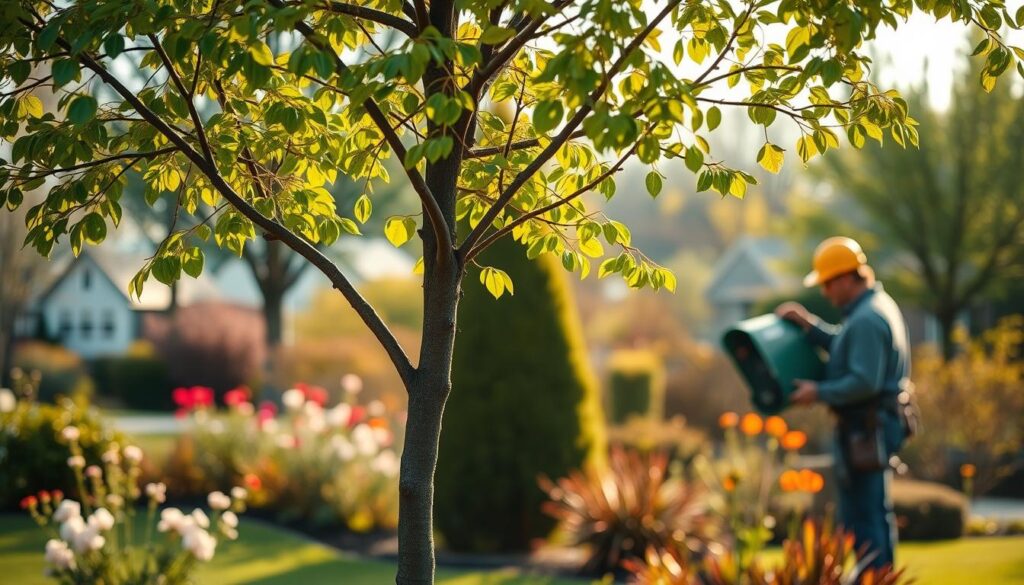
Preventative Treatments and Solutions
Preventative treatments are key to protecting your trees from spring pests and diseases. These can include organic control methods and chemical interventions. The choice depends on the infestation’s severity and your trees’ specific needs.
Organic Control Methods
Organic control methods, like introducing beneficial insects or using horticultural oils, can manage spring pests. These methods are environmentally friendly. They can be used alongside other tree care practices to keep trees healthy.
Chemical Interventions When Necessary
Chemical treatments may be needed for severe infestations. It’s crucial to choose the right chemicals and apply them correctly. Always follow label instructions and consider consulting with a tree care professional if unsure.
Summer Tree Maintenance: Protection During Heat
Keeping your trees safe during summer is key to their health. The heat can be tough, but with the right care, they can do well.
Proper Watering Techniques During Drought
When it’s dry, watering your trees right is crucial. Deep watering helps their roots grow strong, making them more resistant to dry spells.
Deep Watering Methods
To water deeply, use a slow hose or soaker hose. This method cuts down on water lost to evaporation and runoff, getting water to the roots.
Watering Schedules and Timing
Water your trees in the early morning or late evening to reduce evaporation. How often you water depends on the tree, soil, and weather. Trees generally need about 1 inch of water a week, from rain or irrigation.
Mulching Benefits and Methods
Mulching is a great way to protect your trees in summer. It keeps the soil moist, stops weeds, and controls soil temperature.
Organic vs. Inorganic Mulch Options
Organic mulches like wood chips and leaves are popular. They break down, adding nutrients to the soil. Inorganic mulches, like gravel, can work too but don’t offer the same soil benefits.
Proper Application Techniques
Spread a 2-3 inch layer of mulch around your trees, but keep it a few inches from the trunk. This stops moisture from building up against the trunk, which can cause disease.
Summer Storm Preparation
Summer storms can harm trees, especially those with weak branches. Preparing your trees for storms can help prevent damage.
Identifying and Removing Hazardous Limbs
Look for dead, diseased, or damaged branches. Remove these to prevent damage during storms. If unsure, consider hiring a professional.
Cabling and Bracing Considerations
For trees with weak branches, think about cabling and bracing. This adds support, helping prevent branches from breaking in strong winds.
Tree Maintenance Tips for Every Season: A Comprehensive Guide
Effective tree care needs a plan that changes with the seasons. Knowing what your trees need each time of year helps keep them healthy and strong.
Creating a Seasonal Maintenance Calendar
Having a seasonal maintenance calendar is key. It lists tasks for each month. This helps you get ready for the challenges and chances each season offers.
Monthly Task Breakdown
A monthly task breakdown helps you focus on what needs to be done. For example, spring is for pruning and fertilizing. Summer is for watering and mulching. Breaking tasks into smaller parts makes caring for your trees easier.
Record-Keeping for Long-Term Care
Keeping detailed records of your tree care is important for long-term tree health. Tracking your efforts and noting successes and challenges helps you improve your tree care over time.
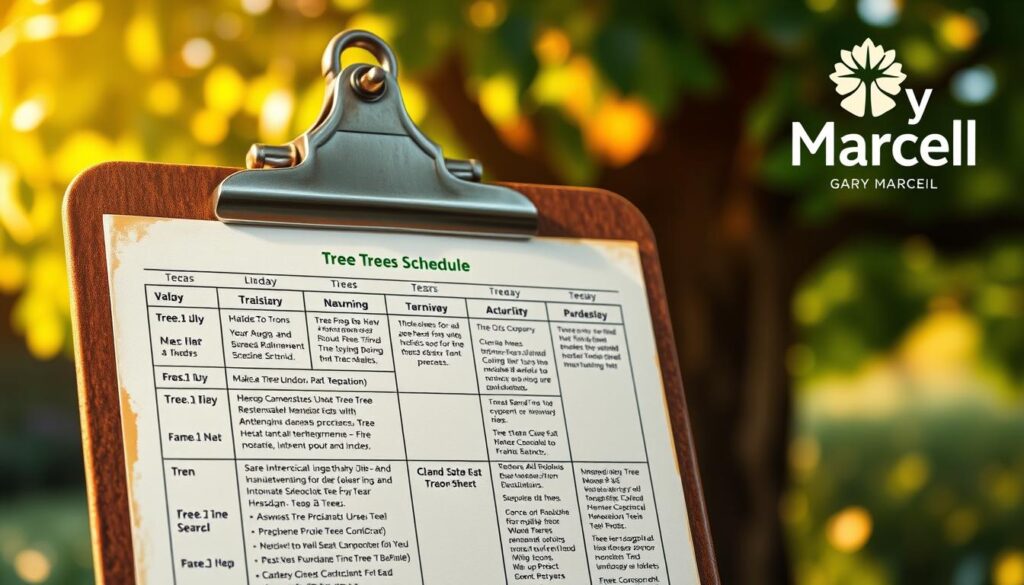
Adapting Care Routines to Climate Changes
As climate change affects weather, you need to adjust your tree care. This means being ready for extreme weather and knowing how climate zones impact trees.
Responding to Extreme Weather Events
Being ready for extreme weather events like hurricanes or droughts is crucial. You might need to secure trees, protect them from wind, or change your watering schedule.
Adjusting Care for Climate Zones
Knowing your local climate zone is essential for tree care. Different zones face different challenges, from temperature to rain. Tailoring your care to your zone helps your trees thrive.
Fall Tree Care: Preparing for Dormancy
Fall is a key time for tree care, with steps needed to protect trees through winter. As the seasons shift, trees need to get ready for the cold. Good fall care helps keep trees healthy and ready for spring.
Fall Pruning Best Practices
Pruning in the fall helps keep trees healthy and strong. It’s important to know what to prune and what to leave to avoid stressing your trees.
What to Prune and What to Leave
Remove dead, diseased, or damaged branches. Deadwood removal stops disease spread and prevents branch failure.
Deadwood Removal Techniques
When cutting dead branches, cut just outside the branch collar. This helps the tree heal and reduces infection risk.
Leaf Management Strategies
Good leaf management is key for tree health. Leaves can be composted or managed on-site.
Composting Benefits for Tree Health
Composting leaves makes nutrient-rich soil for trees. It’s a natural way to recycle and improve soil.
When to Remove vs. When to Leave Leaf Litter
Choose to remove or leave leaves based on your tree care goals. Leaving some leaves as mulch is natural but too many can harm plants.
Pre-Winter Fertilization
Fertilizing trees before winter strengthens their roots. This prepares them for the next growing season.
Root-Strengthening Formulas
Use fertilizers that boost root growth. These formulas have balanced nutrients for tree health.
Application Timing Before Frost
Apply fertilizer before the ground freezes. This lets trees absorb nutrients through winter.
By following these fall tree care tips, your trees will be ready for dormancy. They’ll be set for success in the next year.
Winter Tree Protection: Surviving the Cold
To keep your trees safe in the cold, it’s key to know and use good winter protection methods. Winter weather can harm trees, causing damage that’s not always easy to see. But, this damage can affect their health and shape for a long time.
Preventing Winter Damage
It’s important to stop winter damage to keep your trees healthy. Two good ways to do this are wrapping young trees and using anti-desiccant treatments.
Wrapping Young Trees
Young trees are more at risk in winter because their bark is thinner. Wrapping them with tree wrap or burlap helps protect against cold and wind. This simple step can greatly lower the chance of damage.
Anti-Desiccant Applications
Anti-desiccant sprays stop moisture loss from leaves or needles of evergreen trees and shrubs. Applying an anti-desiccant before the ground freezes helps protect your trees from drying winds.
Snow and Ice Management
Snow and ice can stress trees a lot, possibly causing branches to break. It’s important to manage snow and ice well to reduce this risk.
Safe Snow Removal from Branches
When snow builds up on branches, it’s crucial to remove it carefully to avoid damage. Gently brushing off the snow with a broom or your hands (if the branches are low enough) can prevent branch breakage.
Dealing with Ice Accumulation
Ice on branches is especially hard because it adds a lot of weight. If you can, don’t try to remove the ice, as it can cause more harm. Instead,
“As the ice melts naturally, keep an eye on the tree’s condition and be prepared to provide additional support if necessary.”
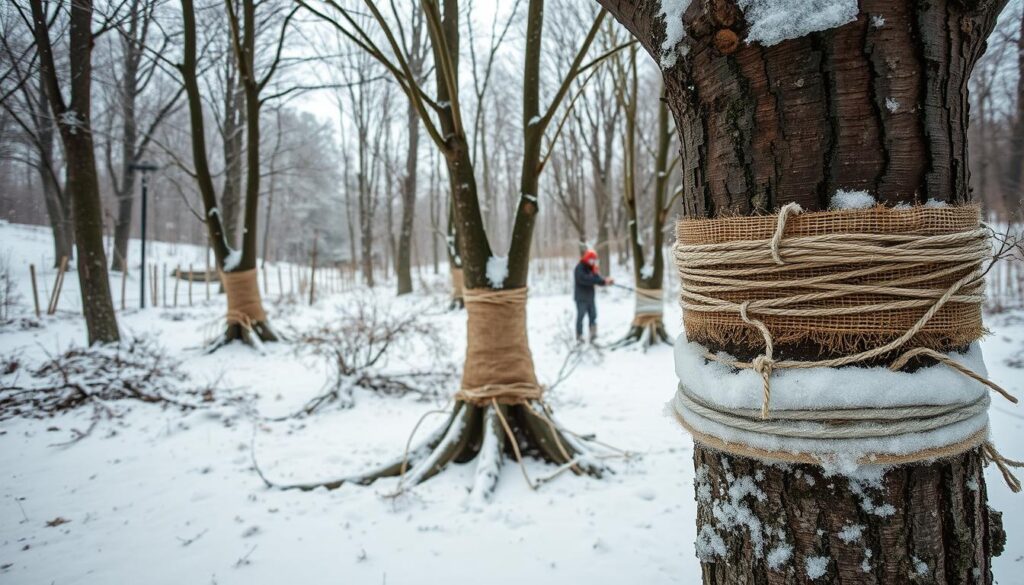
By using these winter tree protection strategies, you can help your trees stay healthy and survive the cold season.
Professional Tree Services: When to Call an Arborist
Knowing when to DIY and when to call a pro is crucial for your landscape. Homeowners can handle many tree care tasks. But, some jobs need a professional arborist’s expertise.
Signs Your Tree Needs Professional Attention
Spotting when a tree needs a pro is key to safety. Look out for structural problems and diseases or pests.
Structural Concerns and Risk Assessment
Trees with issues like dead branches, cracks, or decay are risky. A pro can check these risks and find ways to fix them.
Disease and Pest Infestations Beyond DIY Solutions
If your tree has diseases or pests that DIY can’t fix, call a pro. Arborists have the skills and tools to handle tough tree health problems.
Selecting a Qualified Tree Care Professional
When your tree needs a pro, find a qualified one. Look for the right credentials and ask important questions.
Credentials and Certifications to Look For
Check if the arborist is certified by groups like the International Society of Arboriculture (ISA). This shows they’re skilled and follow best practices.
Questions to Ask Before Hiring
- What experience do you have with trees like mine?
- Can you provide references or examples of previous work?
- What is your approach to tree care, and what methods do you use?
- Are you insured, and what kind of liability coverage do you have?
By asking these questions and checking credentials, you can get your trees the best care.
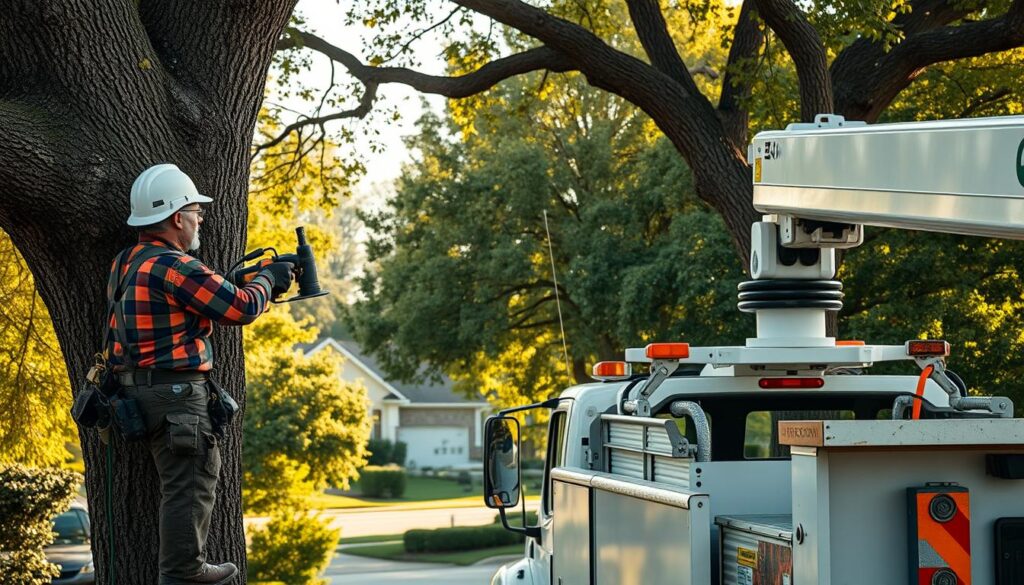
Special Considerations for Fruit and Ornamental Trees
To get the most out of your fruit and ornamental trees, knowing their specific needs is key. Each type of tree has its own needs. Meeting these can greatly improve their health, productivity, and beauty.
Fruit Tree Pruning and Care Schedule
Proper pruning is vital for fruit trees’ health and fruit production. It means cutting off dead, diseased, or damaged branches. This helps the tree grow strong and produce more fruit.
Training Young Fruit Trees
Shaping young fruit trees is important for their future health and fruit. This includes:
- Pruning to create a strong central leader
- Removing branches that are damaged or diseased
- Spacing branches evenly for good air and sunlight
Maintaining Productive Mature Trees
Mature fruit trees need ongoing care to stay healthy and productive. This includes:
- Annual pruning to remove dead wood and encourage fruiting
- Fertilizing based on soil tests
- Watching for pests and diseases
Maintaining Ornamental Tree Aesthetics
Ornamental trees are loved for their beauty and landscaping role. Keeping them looking good requires careful pruning and care.
Shaping Techniques for Visual Appeal
Shaping ornamental trees means understanding their natural growth. Techniques include:
- Selective pruning to enhance natural shape
- Thinning to let more sunlight in
- Reducing branch size for the right look
Preserving Flowering and Foliage Features
For trees valued for their flowers or leaves, special care is needed. This includes:
- Pruning at the right time to avoid cutting off flower buds
- Fertilizing for healthy leaves and flowers
- Protecting trees from pests and diseases that harm their looks
Urban Tree Care: Challenges and Solutions
Urban trees need special care because of the city’s challenges. They face issues like limited space and pollution. These problems can harm their health and shorten their lives.
Navigating Limited Space and Resources
One big challenge is finding enough space for urban trees to grow. We must plan carefully to give them room to thrive.
Root Space Management in Urban Settings
Managing root space is key in cities. We use bigger planting pits and root-friendly materials. Root pruning also helps with restricted growth.
Dealing with Compacted Soils
Soil compaction is a big problem in cities. It limits root growth and air in the soil. Soil aeration and mulching can solve this issue.
Addressing Urban-Specific Tree Stressors
Urban trees face unique stressors like pollution and infrastructure conflicts.
Pollution Tolerance and Mitigation
Urban trees help fight pollution. We choose trees that can handle pollutants. We also reduce pollution to protect them.
Infrastructure Conflicts and Solutions
Conflicts between trees and city structures are common. Root barrier installation and smart tree placement help solve these problems.
Understanding urban tree challenges helps us care for them better. Good urban tree care makes cities look better and improves air quality. It also helps with heat and supports more wildlife.
- Implement strategic root space management techniques.
- Mitigate the effects of soil compaction through aeration and mulching.
- Select pollution-tolerant tree species.
- Plan tree placement carefully to avoid infrastructure conflicts.
Conclusion: Nurturing Your Trees Throughout the Year
Year-round tree maintenance is key for your trees’ health and life span. By following seasonal tree care tips, your trees will thrive. This guide has shown you how to do it.
Knowing your trees’ species and growth patterns is important. So is having a care plan for each season. Spring pruning, summer protection, and winter prep are all crucial.
With this knowledge, you can care for your trees all year. This will make them more beautiful and healthy. Regular care also makes your landscape safer and more beautiful for everyone.
Tree care is a long-term commitment. Stick to your routine, and you’ll have healthy, beautiful trees. They will add joy and value to your property for many years.
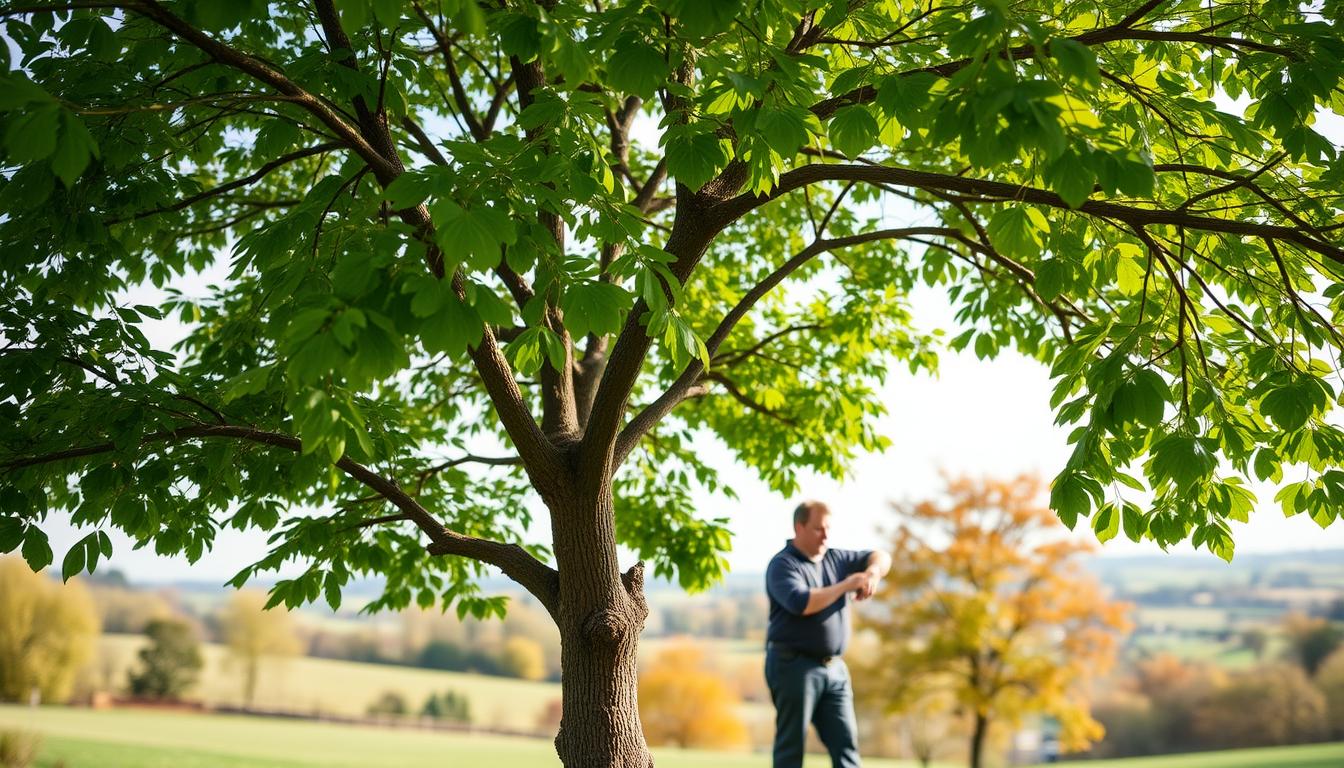
Leave a Reply